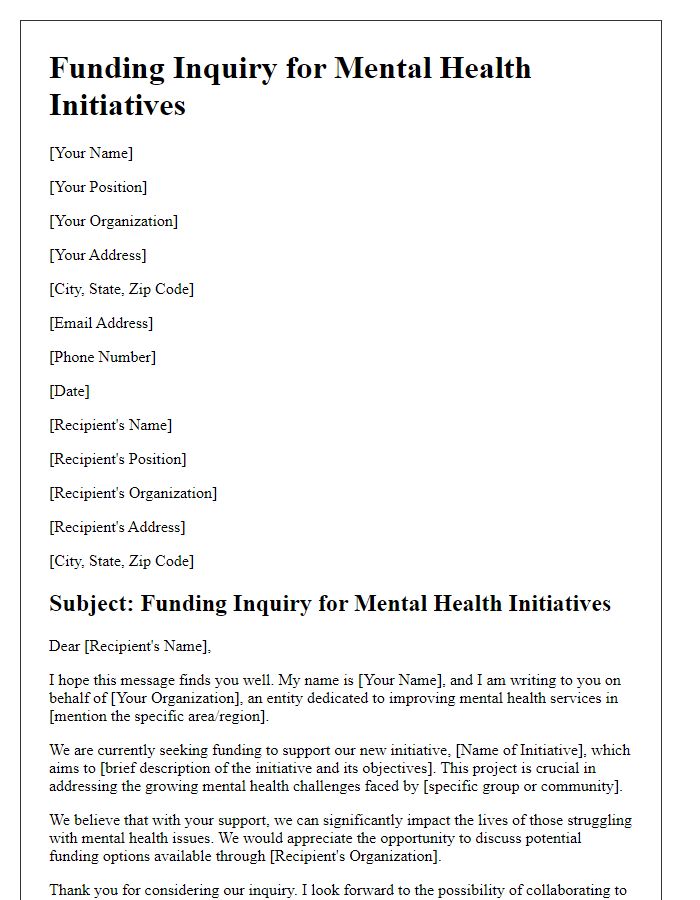Are you seeking funding for a healthcare initiative that could change lives? Writing a compelling request letter is a crucial step in securing the financial support you need. In this article, we'll share valuable tips and a template to help you articulate your vision clearly and professionally. Join us as we explore the essential elements of crafting the perfect funding request letter!

Clear Objective Statement
A clear objective statement for healthcare funding requests outlines specific goals aimed at improving patient care, enhancing facility capabilities, or addressing public health concerns. For instance, securing $500,000 to implement a telehealth program across rural clinics in New York state, targeting an estimated 20,000 underserved patients. The initiative seeks to increase access to specialists, reducing travel distances of over 30 miles for many families. Objectives will include improving patient satisfaction scores by at least 30% within the first year of implementation and decreasing emergency room visits by 15% through proactive health management facilitated by virtual consultations. This funding will enable the organization to enhance its technological infrastructure and ensure sustainability for long-term health benefits.
Comprehensive Project Description
A comprehensive project description for a healthcare funding request focuses on critical aspects such as objectives, target demographics, and expected outcomes. This project aims to enhance mental health services in urban communities, particularly among low-income populations, estimated at over 200,000 individuals in cities like Los Angeles and Chicago. It will implement a multi-faceted approach, including the establishment of telehealth services, which enable remote consultations, and community workshops to educate residents on mental wellness. Funding of $500,000 will facilitate hiring licensed mental health professionals, provide necessary training, and develop outreach programs. Additionally, collaboration with local organizations, such as the National Alliance on Mental Illness (NAMI), will create a support network for individuals and families. Success will be evaluated through metrics such as increased service utilization by 30% within the first year and improved patient-reported outcomes, aiming for a 25% reduction in reported mental health issues.
Detailed Budget Breakdown
A detailed budget breakdown for healthcare funding requests includes specific allocations for various categories. Personnel costs (approximately 40% of the total budget) encompass salaries for healthcare professionals, administrative staff, and support teams. Equipment expenses (about 25% of the budget) highlight expenditures on medical devices, diagnostic tools, and office technology essential for operations. Facility costs (around 20%) will cover rent, utilities, and maintenance for the healthcare facility located in a community with access to underserved populations. Lastly, program expenses (approximately 15%) are designated for patient outreach, educational materials, and community health initiatives, aimed at improving local health outcomes. Accurate forecasting and transparency in each category will enhance funding credibility and support.
Expected Outcomes and Impact
Healthcare funding requests aim to secure financial resources for specific projects that can significantly enhance patient care, operational efficiency, and community health outcomes. Expected outcomes from such funded initiatives may include improved access to essential services, such as primary care and mental health support, particularly in underserved areas like rural communities in the Midwest US. Projects may lead to increased patient satisfaction levels, evidenced by a targeted 20% rise in positive feedback within the first year. Furthermore, funding may facilitate the introduction of advanced telemedicine technologies, resulting in a projected 30% reduction in no-show appointment rates. Ultimately, the impact of these initiatives can contribute to overall public health improvements, potentially decreasing hospital readmission rates by 15% and enhancing preventive care measures, which can save healthcare systems significant costs in the long run.
Supporting Evidence and Research
Healthcare funding requests require robust supporting evidence and research to validate the need for financial assistance. Comprehensive studies highlighting the impact of funding on community health outcomes demonstrate significant improvements, such as a 25% reduction in hospital readmission rates with targeted intervention programs. Research published in the Journal of Health Economics underscores the correlation between increased funding and accessibility to preventive care services, including vaccinations and screenings, which can decrease the incidence of chronic diseases. Notable surveys conducted by the World Health Organization reveal that for every dollar invested in health programs, there is a return of approximately $4, showcasing long-term economic benefits. Detailed analysis of healthcare disparities, particularly in underserved populations in urban areas, emphasizes the urgent need for enhanced funding to address issues like limited access to essential services and high rates of uninsured individuals. These statistics and studies collectively provide a compelling case for securing necessary financial resources to improve healthcare initiatives.
Letter Template For Healthcare Funding Request Documentation Samples
Letter template of financial support request for medical research initiatives.

Letter template of appeal for funding to improve patient care facilities.

Letter template of resource allocation request for preventive health programs.











Comments